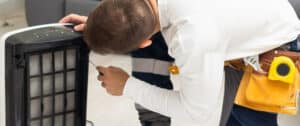The short answer of the question “will an air purifier help with pet allergies” is definitely “yes”. But how? Let’s review in depth!
If you have pet allergies, you’re not alone. In fact, about 10% of the population is allergic to animals.1 While most people are allergic to animal dander (flakes of skin that contain proteins that trigger an immune response), some people are also allergic to animal saliva or urine.
Pet allergies can cause a range of symptoms, from mild (sneezing, runny nose) to severe (trouble breathing, wheezing). If you have pet allergies and are considering getting an air purifier, you may be wondering if it will help relieve your symptoms.
According to the Asthma and Allergy Foundation of America, the best way to reduce pet allergies is to remove the animal from the home. In this article, we’ll explore other ways to reduce pet allergies, including using an air purifier.
How Air Purifiers Work?

Air purifiers by trapping particles in the air, such as dust, pollen, and pet dander. The device contains a filter that collects these particles and cleans the air as it circulates.
There are a few different types of air purifiers, including mechanical filters, activated carbon filters, ozone generators, and ultraviolet germicidal irradiation (UVGI) devices.
Mechanical filters are the most common type of air purifier. They come in a variety of shapes and sizes and can be used for a range of purposes, including reducing pet allergies.
Activated carbon filters are also effective at reducing pet allergies. These filters are made of charcoal that has been treated with oxygen to make it more porous. This makes the charcoal more effective at trapping and removing particles from the air.
Ozone generators emit ozone, a gas that is composed of three oxygen atoms. Ozone is a powerful oxidant and can react with a wide range of molecules, including those that cause allergies.
UVGI devices use ultraviolet light to kill germs and bacteria. This type of air purifier is often used in healthcare settings, but it can also be used in the home to reduce pet allergies.
Air Purifiers and Allergies

There are many different types of air purifiers on the market, but not all of them are effective at reducing allergens. For example, mechanical filters can capture large particles like pet dander, but they’re not very good at capturing smaller particles like dust mites or pollen.
Electrostatic precipitators are more effective at capturing smaller particles, but they can produce ozone as a byproduct, which can trigger asthma symptoms.
The most effective type of air purifier for reducing allergens is a HEPA (high-efficiency particulate air) filter. HEPA filters are able to remove 99.97% of particles that are 0.3 microns or larger from the air, which includes most allergens like pet dander, dust mites, and pollen.
Tips for Using an Air Purifier

Here are a few tips for using an air purifier to reduce pet allergies
- Choose a HEPA air purifier for maximum effectiveness
- Place the air purifier in the room where you spend the most time
- Run the air purifier 24 hours a day
- Change the filter regularly
- Keep doors and windows closed as much as possible
- Vacuum often with a vacuum that has a HEPA filter
- Wash bedding in hot water weekly
By following these tips, you can improve your indoor air quality and create a safer environment for yourself if you suffer from pet allergies.
FAQs
Now that we’ve answered the question, “Do air purifiers help with pet allergies?”, let’s take a look at some frequently asked questions about air purifier.
Will an Air Purifier Help With Pet Allergies?
Yes, an air purifier can help with pet allergies. An air purifier allergens in the air such as dander and fur from pets, which can trigger allergic reactions. Air purifiers reduce airborne particles that can cause irritation and discomfort
Do air purifiers get rid of pet hair?
While air purifiers can help to reduce the amount of pet hair in the air, they will not completely get rid of it. Vacuuming is still the best way to remove pet hair from your home.
Does fresh air help with pet allergies?
Yes, fresh air can help to reduce pet allergies. By opening doors and windows, you can let in fresh air that can help to dilute the allergens in the air.
How long does it take for an air purifier to help with allergies?
It can take a few days for an air purifier to start reducing allergies. However, you may notice a difference in your symptoms within a few hours of turning on the device.
How do you remove pet dander from the air?
There are a few ways to remove pet dander from the air, including using an air purifier, vacuuming often with a vacuum cleaner that has a HEPA filter, and washing bedding in hot water.
Where is the best place to put an air purifier?
The best place to put an air purifier is in the room where you spend the most time. However, you may want to move it around to different rooms if you notice your allergies are worse in certain areas of the house.
The Final Thought
An air purifier can be a helpful tool for managing pet allergies – but it’s not a cure-all. In order to see results, it’s important to choose the right type of air purifier and use it correctly. By following the tips above, you can create a cleaner indoor environment for yourself and may find relief from your allergy symptoms.
Please comment below if you have any questions left. Moreover, if you found this article helpful, then share our website AirCleansy with your friends and family. We are dedicated to helping people improve the air quality in their homes and would love for as many people as possible to learn about us.

